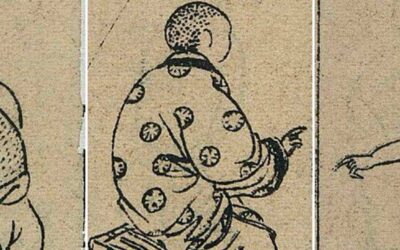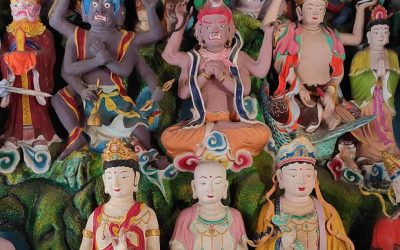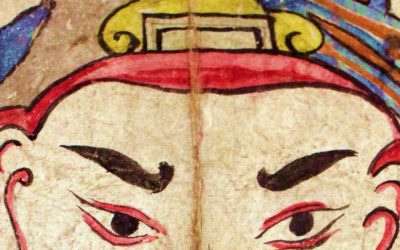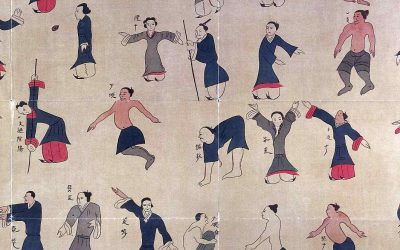A Giant Mandala in the Heart of Tibet
The Palkor of Gyantze is one of Tibet’s great marvels and a unique jewel of universal architecture and art. Its shape, scale, and iconography defy comparison with any other construction.
Amidst some of the highest mountains of central Tibet, on the ancient trade route linking Lhasa with India, lies the small town of Gyantze. There stands one of the most singular and dazzling monuments of the Buddhist world: the Palkor Chöde. With a silhouette that astonishes from the very first glance, the Palkor is neither palace nor fortress, neither monastery nor temple, but rather a kind of three-dimensional architectural mandala: a kumbum.
- An Architectural Form Without Parallel
While most Tibetan temples follow horizontal layouts inspired by Indian or Chinese models, the Palkor rises like a stepped pyramid of multiple levels, each containing rows of chapels. This structure follows a symbolic design, representing a universe through which the pilgrim ascends toward enlightenment. The term kumbum literally means “one hundred thousand images,” and in the case of the Palkor, the name is no exaggeration.
- An Artistic Treasure Without Equal
The interior of the kumbum contains 108 chapels distributed across six concentric levels. Each one is adorned with frescoes, statues, and mandalas that, on their own, could justify the existence of an entire religious center. In fact, anywhere else in the world, a single one of these chapels would be enough to attract pilgrims, scholars, and art lovers alike. The mural paintings that cover its walls—rendered in the Nepali-Tibetan style of the 15th century—still preserve a vividness of color and detail that has withstood centuries of weather, war, and neglect. Many of these images offer a compendium of cosmology, medicine, tantric ritual, and visions of the afterlife.
- History of Its Construction
The Palkor was built between the late 14th and mid-15th centuries under the patronage of the prince of Gyantze, Rabten Kunzang Phak, during a period of relative political stability and cultural openness in Tibet. It was a time when multiple Buddhist schools coexisted, and the monastery annexed to the kumbum was home to at least three traditions: Gelug, Sakya, and Kagyu. This coexistence explains the rich iconographic and doctrinal diversity found within, making the Palkor a living testament to a plural and dynamic Tibet.
- Symbolism in the Tibetan World
The Palkor is not merely a temple: it is an architectural mandala to be walked through, a physical visualization of the path to enlightenment. Ascending its levels is like progressing through the stages of tantra—from the outer circles of protection to the central deities who embody emptiness and compassion. Each chapel serves as a gateway to a specific teaching, and the whole structure forms a miniature cosmos. Its design, layout, and ritual function make it a monument of profound symbolic depth.
Visiting the Palkor Today
Despite the ravages of time and the iconoclastic campaigns of the 20th century, the Palkor still stands—lofty and magnificent, a reliquary of wisdom and beauty. Climbing its levels, pausing in its chapels, and attempting to uncover its mandalic meaning is a transformative experience. For those who observe it with care, the Palkor is not merely a monument—it is a silent teaching, a vertical pilgrimage to the heart of Tibetan Buddhism.
The mandalic structure of the Palkor recalls, in both function and symbolism, the great monument of Borobudur in Indonesia. Both can be read as three-dimensional mandalas, designed for the pilgrim to physically experience the transformations that masters achieve on the psychological plane.
About me: I have spent 30 years in China, much of the time traveling and studying this country’s culture. My most popular research focuses on Chinese characters (Chinese Characters: An Easy Learning Method Based on Their Etymology and Evolution), Matriarchy in China (there is a book with this title), and minority cultures (The Naxi of Southwest China). In my travels, I have specialized in Yunnan, Tibet, the Silk Road, and other lesser-known places. Feel free to write to me if you’re planning a trip to China. The agency I collaborate with offers excellent service at an unbeatable price. You’ll find my email below.
Last posts
The Smallpox Goddess (Doushen)
The Smallpox Goddess (Doushen) The Smallpox Goddess (Doushen 痘神) is part of a group of goddesses whose primary role was the protection of children. In the final years of the imperial era, they operated under the authority of Bixia Yuanjun, the daughter of the Emperor...
Legends of the Mother Goddess
Legends of the Mother Goddess I am pleased to share with all you that the Italian translation of my book Legends of the Mother Goddess (and Other Myths of Goddesses and Women from the Peoples of China) has now been published and is available for purchase. As many of...
Laozi’s Mother is the goddess who created the world
Laozi’s Mother is the goddess who created the world In Taoist thought, great mysteries are not explained with definitive statements, but with paradoxical images, fragmentary myths, and bodily metaphors. One such mystery is the origin of the world—and for Taoism, that...
Does the Daodejing Contain the Oldest Creation Myth of China?
Does the Daodejing Contain the Oldest Creation Myth of China? An introductory article on Chinese mythology asserts (twice) that the myth of the creation of Huangdi (the Yellow Emperor) should be considered one of China's creation myths, following the model of...
The Wenzi Begins: Echoes from a Forgotten Taoist Voice
The Wenzi Begins: Echoes from a Forgotten Taoist Voice The Wenzi (文子) is an ancient Daoist text attributed to a disciple of Laozi. Although its authenticity has been debated throughout history, its content clearly reflects the Daoist worldview and its influence on the...
A Humble Proposal for Rethinking Historical Periodization: To Go Beyond Dynasties in Chinese History
A Humble Proposal for Rethinking Historical Periodization: To Go Beyond Dynasties in Chinese History Historical narratives are never neutral. The way we divide time reflects not only the facts we choose to remember, but also the frameworks we use to interpret them. In...










